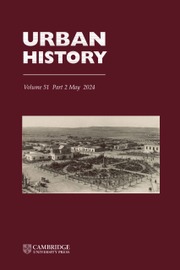Article contents
Editorial
Published online by Cambridge University Press: 09 February 2009
Extract
The appearance of the Urban History Yearbook marks an important and exciting stage in the development of its subject, not only in this country but wherever it is studied. The study of the urban past is no new thing but what has been so striking about it in the course of the last decade or so has been the almost overwhelming growth in the numbers of scholars taking part in it and the immensely wider range of topics and techniques they have been pursuing.
- Type
- Editorial
- Information
- Copyright
- Copyright © Cambridge University Press 1974
References
1. The most comprehensive bibliographical account of the development of urban history in the United States down to the mid-1960s is Glaab, Charles N., ‘The historian and the city: a bibliographic survey’ in Hauser, Philip M. and Schnore, Leo F. (eds), The Study of Urbanization (1965), 53–80Google Scholar, but the leading critical commentaries on it so far have been by Lampard, Eric E., ‘American historians and the study of urbanization’, American Historical Review, lxvii (1961), 49–61CrossRefGoogle Scholar, and ‘Urbanization and social change: on broadening the scope and relevance of urban history’ in Handlin, Oscar and Burchard, John (eds), The Historian and the City (1963), 225–47Google Scholar; Davis, A. F., ‘The American historian vs. the city’, Social Studies, lvi (1965), 91–6, 127–35CrossRefGoogle Scholar; Hoover, Dwight W., ‘The diverging paths of American urban history’, American Quarterly, xx (1968), 296–317.CrossRefGoogle Scholar
2. For a detailed historiographical account see Dyos, H. J., ‘Agenda for urban historians’ in The Study of Urban History, ed. Dyos, (1968), 1–46.Google Scholar
3. The most recent contribution to this debate and perhaps also the most searching is Lampard, Eric E., ‘The dimensions of urban history: a footnote to the “urban crisis”’, Pacific Historical Review, xxxix (1970), 261–78CrossRefGoogle Scholar, but the following all have valuable points to make: Handlin, Oscar, ‘The modern city as a field of historical study’ in The Historian and the City, ed. Handlin, and Burchard, (1963), 1–26Google Scholar; Tilly, Charles, ‘The stake of urbanization’, Comparative Studies in Society and History, x (1967), 100–113CrossRefGoogle Scholar; Lubove, Roy, ‘The urbanization process: an approach to historical research’, Journal of the American Institute of Planners, xxxiii (1967), 33–9CrossRefGoogle Scholar; Warner, Sam Bass Jr, ‘If all the world were Philadelphia: a scaffolding for urban history, 1774–1930’, American Historical Review, lxxiv (1968), 26–43CrossRefGoogle Scholar; Wade, Richard C., ‘An agenda for urban history’ in The State of American History, ed. Bass, Herbert J. (1970), 43–69Google Scholar; White, Dana F., ‘The underdeveloped discipline: interdisciplinary directions in American urban history’, American Studies, ix (1971), 3–16Google Scholar; Blumin, Stuart M., ‘In pursuit of the American city’, Journal of Interdisciplinary History, ii (1971), 173–8CrossRefGoogle Scholar; Thernstrom, Stephan, ‘Reflections on the new urban history’, Daedalus, c (1971), 359–75Google Scholar. For other references see Ebner, Michael H., ‘The new urban history: bibliography of methodology and historiography’, Council of Planning Librarians Exchange Bibliography No. 445 (1973)Google Scholar, and Stelter, Gilbert A., Canadian Urban History. A Selected Bibliography [Laurentian University Social Science Research Publication No. 2] (1972)Google Scholar, which is a good deal wider in scope than it might appear.
4. For some characteristic British approaches, see Briggs, Asa, ‘Historians and the study of cities’, George Judah Cohen Memorial Lecture (1960), 3–24Google Scholar, and ‘Urban perspectives: a review article’, Urban Studies, iv (1967), 165–9CrossRefGoogle Scholar; Checkland, S. G., ‘The British industrial city as history: the Glasgow case’, Urban Studies, i (1964)Google Scholar, and ‘Toward a definition of urban history’, in The Study of Urban History, ed. Dyos, (1968), 342–61Google Scholar; Lawton, Richard, ‘An age of great cities’, Town Planning Review, xliii (1972), 200–24.Google Scholar
5. See, for example, Glynn, Sean, ‘Approaches to urban history: the case for caution’, Australian Economic History Review, x (1970), 218–25CrossRefGoogle Scholar; and Hobsbawm, E. J., ‘From social history to the history of society’, Daedalus, c (1971), 20–45.Google Scholar
6. ‘Two visions of the city’ [review of The Victorian City: Images and Realities, ed. Dyos, H. J. and Wolff, Michael (1973)]Google Scholar, Times Higher Education Supplement, 7 09 1973.Google Scholar
7. Dyos, H. J., Urbanity and Suburbanity (1973), 20–5.Google Scholar
8. The basic approach of the local historian was originally set forth by Finberg, H. P. R., The Local Historian and his Theme (1952)Google Scholar, but see also his chapter on that theme in Approaches to History, ed. Finberg, H. P. R. (1962), pp. 111–25Google Scholar; also, the locus classicus of the subject, Hoskins, W. G., Local History in England (1959)Google Scholar, and a more recent statement on the application of the comparative method in a lecture by Everitt, Alan, New Avenues in English Local History (1970).Google Scholar
- 1
- Cited by


